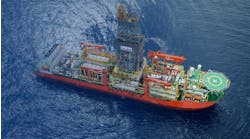Tracy Dulle, Technology Editor, Surface Systems & Vessels
Offshore oil and gas exploration activities in the Middle East continue to intensify. Activity has doubled in the last five years, with growth fueled by the development of very large oil and gas fields. The rising price of oil has also encouraged investment and enhancement of existing fields.
Infield Systems projects 48 new offshore fields to develop in the Middle East in the next five years.
Drilling contractors have relocated rigs from other regions into the Middle East and this trend is expected to continue during 2008, according to Lamprell, a provider of specialist engineering services based in the United Arab Emirates (UAE).
Offshore field development in the Middle East.
During 2007, Lamprell commenced a range of major newbuild projects, with two Scorpion LeTourneau Super 116 jackup drilling rigs and two Seajacks liftboats being the primary projects. As 2008 began, Lamprell also successfully completed the largest single jackup rig rehabilitation and upgrade project ever undertaken by the company, the Nabors Drilling 660 project.
The company believes the market strength will continue and expects to see a significant increase in the regional rig count over the next few years. To keep up with demand, Lamprell is constructing a new Hamriyah deepwater facility in the Hamriyah Free Zone in the UAE. The facility will be ready to fabricate in early 2009, and progress is in line with expectations.
Arabian Gulf
Saudi Aramco’s Manifa development program aims to add 900,000 b/d of Arabian heavy crude production by 2011. J. Ray McDermott won the contract for the engineering, procurement, fabrication, transportation, installation, and hookup of offshore platforms.
The Manifa offshore facilities will consist of 13 new platforms plus modifications to 26 existing observation well platforms. The new facilities support the structures required for the six oil production deck modules that are designed to accommodate equipment required for the electric submersible pumps and seven new water injection platforms.
Meanwhile, Qatargas recently achieved another major project milestone with the installation of the second of three new wellhead platform topsides in the North field, 80 km (50 mi) offshore Qatar.
The offshore mechanical completion work is under way and leads to handover of the facilities to Qatargas 2 Operations for final start-up. The offshore facilities will supply gas for two 7.8 million metric ton (8.6 million ton) per year liquefied natural gas processing trains currently under construction onshore in Ras Laffan City.
Elsewhere in the Arabian Gulf, Dana Gas has agreed to explore and develop its western offshore concession in Sharjah, UAE. The deal marks Dana Gas’ entry into the Gulf Corporation Council (GCC) E&P sector, and is also the first offshore upstream asset for the company in the Middle East.
The concession agreement covers a total offshore area of over 1,000 sq km (386 sq mi), and includes the development of the Zora gas field within Sharjah, which was discovered in 1979.
Qatar Petroleum and Maersk Oil have agreed on a plan for development of the block 5 extension area off Qatar.
The 2008 Field Development Plan comprises drilling of up to six horizontal wells from the Al Shaheen field “I” location in block 5 into the extension area. Oil production from the extension area is expected to reach a level of up to 6,000 b/d in early 2010.
Black Sea
Stratic Energy has begun gas production from its Ayazli gas field in the Black Sea offshore Turkey.
Ayazli is the third gas field to start production under Phase 1 of the South Akcakoca sub-basin development. The Akkaya and East Ayazli gas fields started production last year. Initial flow rates from Ayazli support operator estimates that production from the field will average over 10 MMcf/d (283,000 cm/d) of natural gas.
Operator TPAO has also started well intervention operations to add further perforations on the East Ayazli-2 well in order to increase production from the field.
Arabian Sea
Niko Resources Ltd. has signed four offshore production sharing agreements (PSAs) with the president of the Islamic Republic of Pakistan and Government Holdings (PVT) Ltd., through the Secretariat of the Ministry of Petroleum and Natural Resources.
The initial term of the exploration work in the Arabian Sea is for five years. In each block, a minimum of 200 sq km (77 sq mi) of 3D seismic is to be acquired in the first phase of the initial term.
null





